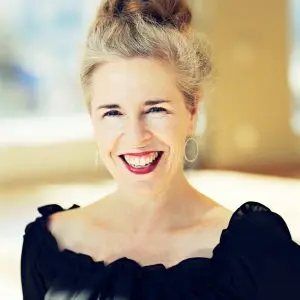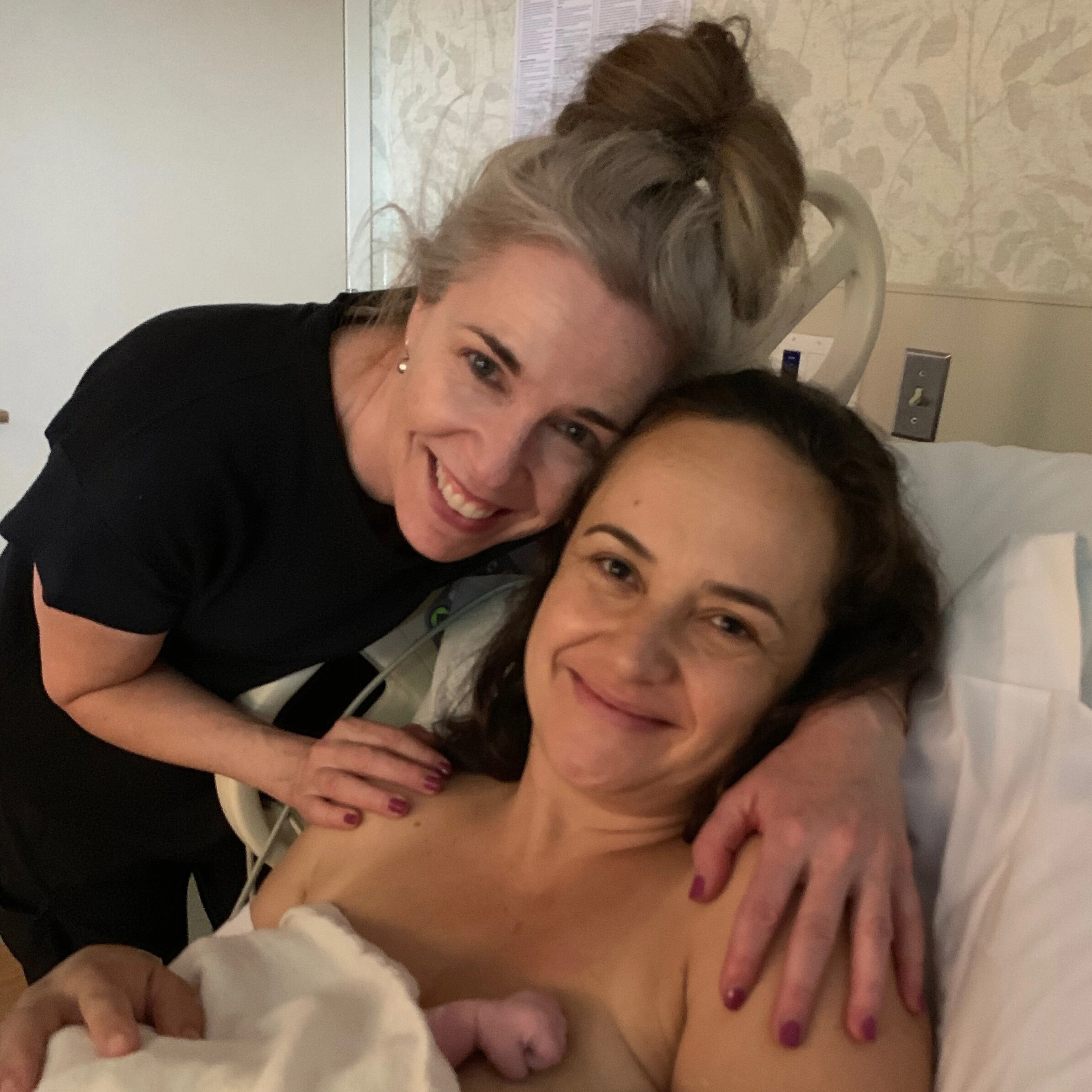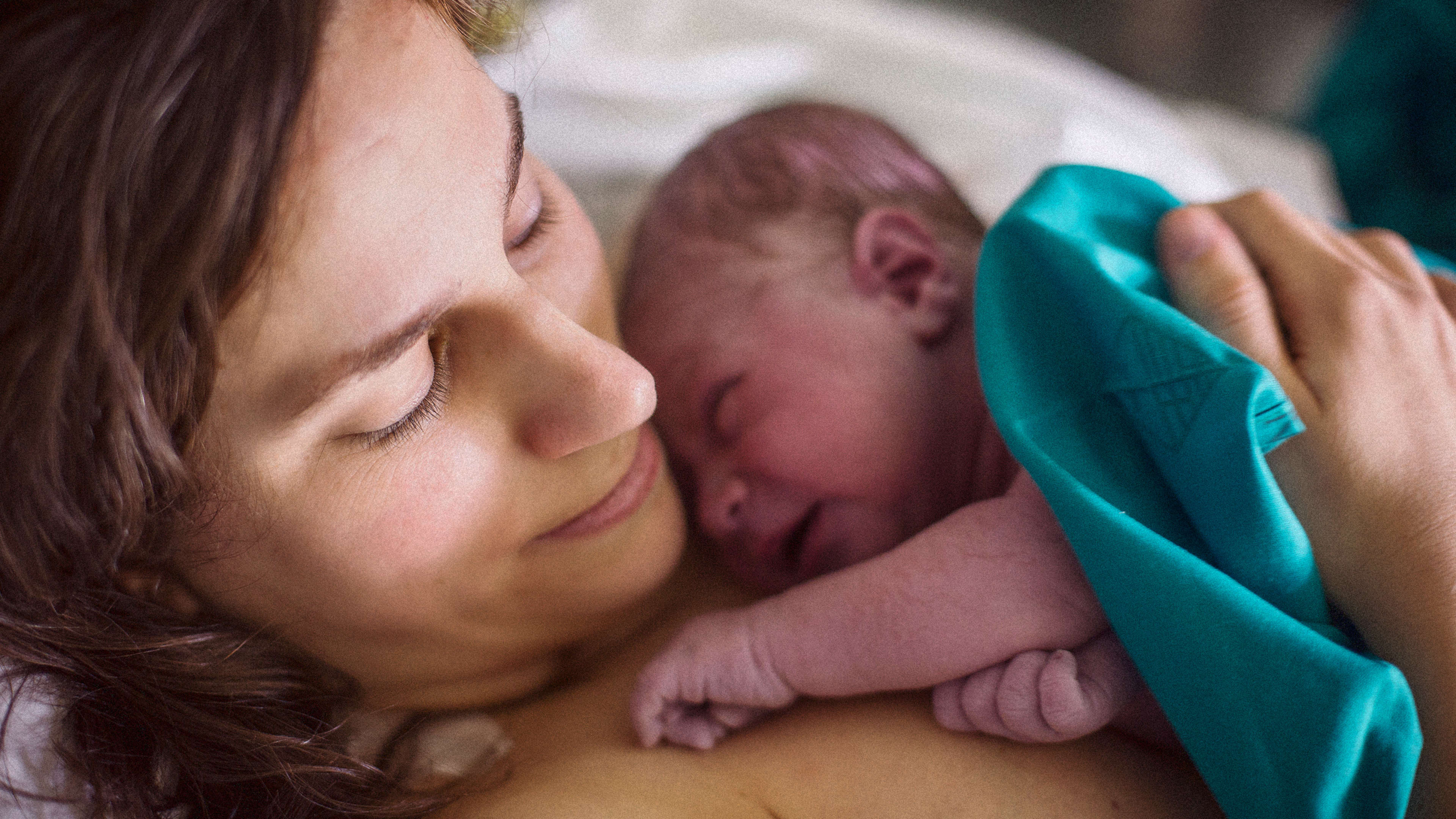Kim Holden was one of the founding principals of the prominent architecture firm SHoP. In addition to her design role, as managing principal, Holden guided SHoP’s strategic development, shaped its operations and staff, and spearheaded cultural initiatives for the studio as it grew from 5 to over 200 people. After almost 30 years in the design world, Holden switched careers, founded DOULA X DESIGN, and now supports women as a birth and postpartum doula. Here, she discusses what she learned building a successful practice, how she transitioned from being an architect to a doula, and how the birthing experience can be redesigned to put mothers first.

Kim Holden: My high school had incredible photography and dance facilities, and when I wasn’t studying, I was in one of those two places. I realized that I wanted to do something in a creative field, I studied art history and studio art in college and found a job in advertising when I graduated.
Advertising wasn’t my calling though, so I took night classes in architectural rendering and interior design, and that led me to the Career Discovery program in architecture at the GSD in the summer of 1989. I absolutely loved it—and was good at it—and knew that architecture was for me.
JG: How did SHoP come into being?
KH: With Bernard Tschumi as Dean at Columbia, students were exposed to a wide range of design philosophies. You could take Bob Stern or you could take Greg Lynn, on opposite ends of the spectrum. Being at a school where all different styles were celebrated, as well as general dissatisfaction with having to choose between being Howard Roark or a corporate cog, all informed the firm we—[SHoP founders] Chris, Bill, and Corie Sharples; Gregg Pasquarelli; and I—wanted to create.
Four of the five of us graduated in 1994 with master of architecture degrees, at the tail end of a recession and just as digital technology was being used in other industries. We saw an exciting opportunity to use the technology in architecture. That’s how SHoP came into being—we were in agreement that our shared vision for the profession did not exist and we saw an opportunity to create a new model of practice. Most importantly, we wanted to build.
JG: You left SHoP almost two years ago. Tell me about this.
Women have been doing this since the beginning of time. Our bodies are literally designed to give birth.”
KH: When SHoP grew after the recession, the growth was fast and furious with a huge increase in the number, scale, and size of our projects. There were many days when it felt like the wheels were falling off because the office was one step behind the operational bandwidth required to handle the surges—a good problem to have, I realize, but challenging, nonetheless.
I took on the role of managing the growth by creating a road map for the firm, implementing new systems, streamlining operations, and giving the staff opportunities to enhance their roles and be part of the vision, all while striving to maintain the culture of the office and respect each person’s individual goals. When the firm found its footing again, I was in a different place. I started asking myself a lot of questions in relation to the firm—what am I passionate about, what is important to me in work and life, and how can I incorporate more of those things into my career?
JG: Where did you first get the idea to become a doula?
KH: I have two daughters, 17 and 12, and I had a doula and midwife for the births of both. My first birth was as unpredictable and as dramatic as a birth can be, but because of the women surrounding me, I had an incredibly positive experience. I was so transformed by it that I considered switching professions at that time and going back to school to become a midwife! However, I said to myself, “You need to get a grip. You have an architecture degree and a burgeoning firm—that’s what you need to focus on.”
Four and a half years later, I had the same team for the birth of my second daughter, and again, I thought about switching professions. However, it was 2007 and just coming up on the recession, so it was all hands-on deck at SHoP. Again, I told myself that I needed to get a grip, but those experiences really stayed with me.
JG: Did you know that’s what you wanted to do as you were leaving?
KH: Not at all. Everything started with a trip to Nepal. When I was still at SHoP, we were hired by Kids of Kathmandu to rebuild the schools that were destroyed by the April 2015 earthquake. I led the project, but I had never gone. Shortly after I left SHoP, I finally had an opportunity to travel there with two other women, one of whom was the cofounder of the organization, to visit the schools and to spend time in the orphanage that KoK supports, coordinating health and hygiene initiatives for girls and young women.
That got me started thinking about what I would do next. I kept coming back to the same feelings of helplessness and frustration about what was happening in the world politically, with women’s issues and with healthcare. My criteria evolved into doing something that would empower women and girls, something that I could do on my own, and something with a degree of flexibility, as I’m still raising and co-parenting my teenagers.

JG: That’s great criteria.
KH: Even after my two experiences with birth and contemplating midwifery, that had not crossed my mind. Then, I was in Maine, where my family lives, and made one last visit to the rocks. While I was sitting there a lightbulb just went off in my head, “I think the ship has sailed on midwifery, but what if I become a doula?”
I immediately started researching and realized that there was a lot of opportunity to promote birth empowerment, and to expand the notion of what a doula is and the positive impact a doula can have. Women’s birth experiences, whether positive or negative, stay with them for life. I also realized that my work could be a stepping stone for greater advocacy. It met all of my criteria.
JG: Where did you begin?
KH: I had a mentor in the woman who was my doula, and I started down a path of classes, workshops, trainings, and building relationships, which I parallel tracked with conceiving my mission and setting up the business. Being a business owner previously, a lot of things were no-brainers.
JG: What is the mission that you’ve established for this practice?
KH: A doula’s purpose is to provide non-medical, emotional and physical support to a woman and her partner through pregnancy, labor, birth, and postpartum. The goal is to create a positive and empowering birth experience—essentially to “mother” the mother.
My philosophy is that women have been doing this since the beginning of time —our bodies are literally designed to give birth. I promote understanding of anatomical and physiological design in birth, and I do whatever I can to create safe space for the mother.
JG: How does your architecture training affect all this?
KH: Birth is a design problem. Design plays a huge role in the way the baby descends and engages in the pelvis during labor. There are techniques that can potentially shorten labor and decrease the likelihood of an unnecessary C-section. Movements, lunges, and inversions during pregnancy and labor can facilitate positioning and rotation of the baby in a way that creates a path of less resistance for easier delivery, adaptable for a medicated or non-medicated birth. I’ve done it with my clients and it works.
JG: What about the actual environment in which women give birth?
KH: The environment in which the birth is happening is very important. Other mammals seek a place where they feel safe, have privacy, and are unobserved when giving birth, and humans should be no different. I have seen facilities in other countries where you walk into a delivery room, and you might mistake it for an acrobatic yoga studio. There are exercise balls, aerial silks, yoga mats, comfy chairs, dim lights, etc. It shows a different attitude towards birth—it normalizes birth.
I also study the current hospital system and use my design background to rethink the design and flow of labor and delivery. When you check into a hospital as a pregnant woman, you’re asked to put on a gown, and from the very beginning you are made to feel like you are sick patient. Your sense of agency is compromised, your confidence erodes, the “fight or flight” hormones kick in, potentially leading to a stalled labor, and ultimately a less than positive birth experience.
The current system is driven by profitability and fear of liability, and is entirely at odds with what women need when giving birth. I don’t quite know where this is all going to lead, but I’m interested in creating awareness around navigating women’s birth environments and perhaps one day redesigning them.
JG: You have some clients who are architects. Are there patterns or issues in preparing for birth that you’re seeing that are specific to them?
KH: We talk about going back to work, and there’s a lot of anxiety about not being available 24/7. Women are concerned their employers won’t allow the flexibility they need and there are also concerns about not being able to network in the same way.
Architecture can be a particularly all-consuming profession which, by nature, is with odds with the unrelenting demands of motherhood and parenthood. There were countless mornings when I arrived at work after a bumpy start of getting everyone up and out the door, and I just wanted to crawl under my desk to take a nap or have an ugly cry.
JG: Tell me about the postpartum period.
KH: Today, women are sent home so soon after birth, and from that point on, it’s all about the baby, and no one is checking in on them. A new mother literally just had another human being come out of her body. Think about that! There is a lot of healing that needs to happen, physically and emotionally, for the mom, and adjustment for the partner and the entire family. The expectations that social media puts on new moms to look good and bounce back are unrealistic and only help contribute to feelings of inadequacy which can increase the risk for postpartum depression. There is enough pressure on new mothers already. A suggestion: follow Amy Schumer on Instagram for a postpartum reality check and some comic relief.
JG: Looking back at everything, what have been the biggest challenges throughout your career?
KH: The biggest challenge for me was the work-life balance, without a doubt. I always hoped that having my own firm would allow for that, and I did have more flexibility than most, but there was just a lot more on my plate all around after my girls were born.
I got tired of “having a family” being the exception for so many working people in our society, and fed up with the expectation that you should be able to operate professionally and pretend that you don’t also have a second full-time job as a parent. That’s just not realistic.
You look at other countries, Denmark for instance, and family life is integrated into how businesses operate. There is a general attitude that if you support women, and families, to help their children get a good start in life—through enhanced benefits and initiatives, family leave, and flexibility—there will be a positive ripple effect that will ultimately translate into a better life, more productive work, and a happier society. The point is that family life is not a “women’s issue,” rather it is a societal issue and it should be all hands on deck to try to improve upon the current system.

JG: On the flip side, what have been the biggest highlights?
KH: I love being in touch with SHoPpers—hearing about what they’re doing and how they’re contributing to the world. When I learn that that a former colleague has forged a path that is in some way inspired by their experiences at SHoP, that makes me really happy. Raising my daughters though, without a doubt, is my biggest highlight.
JG: How does having built a hugely successful practice like SHoP affect what you do now?
KH: So much of building the firm was flying by the seat of our pants, and just simply problem-solving at all scales. There was always a problem to solve—a design problem, a practice problem, a human problem. The biggest lesson for me was “listen and be adaptable.” That was how we approached design and the growth of the firm. The fact that we were able to build SHoP from 5 people to over 200—I didn’t think in a million years that I could do that. But now I feel like I can do anything.
This interview was adapted with permission from Madame Architect. Read the original here.
Recognize your brand’s excellence by applying to this year’s Brands That Matter Awards before the early-rate deadline, May 3.
